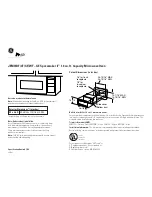
For Best Results:
1. When determining time for a particular food,
begin by using the minimum time and check
occasionally for desired doneness.
2. Small quantities of food or foods with low
water content may burn, dry out, or become
hard if cooked too long.
3. Do not cook eggs in the shell. They may
burst.
4. Foods with non-porous skin or membrane (i.e.
apples, potatoes, eggs) should be pierced
when heated whole to prevent bursting.
5. Do not use narrow neck bottles in the
microwave oven. They may shatter.
Defrosting Frozen Foods:
1. Foods that have been frozen in non-metallic
wrapping can be placed directly in the oven
for thawing.
2. If some portions of the foods thaw faster than
other areas, cover the thawed portions with
small pieces of aluminum foil. This helps slow
down or stop the defrosting process in the
shielded areas.
Browning:
There are some foods which are not cooked
long enough in the microwave oven to brown
and for more eye appeal may need additional
color. Coating mixes such as SHAKE & BAKE
®
, paprika, steak sauce or browning sauce such
as Kitchen Bouquet
®
or Worcestershire sauce
may be used on chops, meat patties or chicken
parts. Roasts and poultry (cooked for 15
minutes or longer) brown nicely without anything
added.
Browning Dish:
Micro Browning dishes may be used to achieve
a brown surface on small items such as steaks,
chops, pancakes, etc. Follow instructions
provided with Micro browning dish.The Micro
browning dishes are designed only for use in
microwave ovens. Do not use in conventional
oven or range top.
NOTE:
DO NOT PREHEAT THE BROWNING
DISH ON THE TURNTABLE TRAY MORE
THAN 8 MINUTES.
Time Variations:
Foods available vary throughout the country and
may cause cooking times to differ from those
given in the Cooking Guide. For this reason,
cooking times given are approximate. Factors
that may affect cooking time include starting
temperature, volume, size and shape of foods
and utensils used. As you become more familiar
with the oven, you will be able to adjust the
timing to these factors.
Cooking Utensils:
1. Most glass, glass ceramic, and heat resistant
glassware utensils are excellent. Those with
metallic trim should not be used in the
microwave oven. (Check Cooking Guide for
"DISH TEST".)
2. Paper napkins, towels, plates, cups, cartons,
freezer wrap and cardboard are great
convenient utensils. Some recycled paper
products may contain impurities which when
combined with hot fat could cause sparking
(arcing) or fires when used for cooking in the
microwave oven. Do not use. (CONSULT
COOKING GUIDE FOR CORRECT USE OF
THESE PRODUCTS.)
3. Plastic dishes, cups, freezer containers and
plastic wraps may be used in the microwave
oven. Follow Manufacturers' instructions of
information given in Cooking Guide when
using plastics in the microwave oven.
4. Meat utensils and utensils with metallic trim
should not be used in the microwave oven.
For more instructions on the proper use of
metal in your oven, please read the
Introduction section in the Cooking Guide.
When using foil, skewers, or utensils made of
metal in the oven allow at least one inch of
space between metal material and interior
oven walls. If arcing (sparking) appears,
remove metal material (skewer, etc) and
transfer to a non-metallic container.
5. Do not pop popcorn in your microwave oven
unless in a special microwave popcorn
accessory or unless you use popcorn labeled
for use in microwave oven. Because of the
heat generated, without these precautions,
the container could catch fire.
- 15 -
OTHER HELPFUL INSTRUCTIONS












































